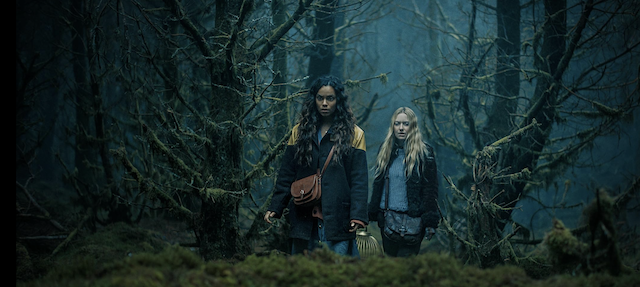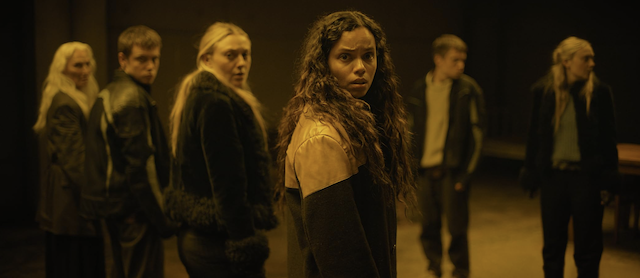
©New Line Cinema
Mirrors are superficially meant to reflect how people are physically presented to the world. However, they ultimately serve as a way for the outside world to put those steered by their emotions, including vanity, on display to be judged by others, especially those they don’t intimately know. Up-and-coming genre auteur, Ishana Night Shyamalan, reflected on the works of her Oscar-nominated father, M. Night Shyamalan, to explore that concept in the new supernatural horror movie, The Watchers.
Ishana, who previously penned and helmed several episodes of her father’s psychological horror television series, Servant, made her feature film directorial and writing debuts on The Watchers. Like with his famous genre movies, notably The Sixth Sense, The Watchers, which he served as a producer on, is a well-paced supernatural horror feature that’s driven by a high-concept premise.
The new drama infuses the darkness of Grimms’ fairy tales into a contemporary thriller. The new film, which is based on the novel of the same name by A.M. Shine, emphasizes the importance of people contemplating who they are without being influenced by the watchful gaze of the outside world.

©New Line Cinema
The Watchers follows Mina (Dakota Fanning), a 28-year-old artist, as her boss at a pet store in Galway, Ireland asks her to deliver a parrot to a zoo near Belfast. She agrees, as she doesn’t wish to contend with the upcoming anniversary of her mother’s death, as well as her estranged twin sister’s attempt to reconnect with her during the emotional time.
During Mina’s journey, she must drive through a sprawling forest, and stops for gas before she enters the remote location. However, she fails to notice the board plastered with multiple Missing Person posters from the surrounding area.
Upon entering the forest, Mina’s car breaks down, which leads her to start walking in her quest to find help. After ducking out of the way of a flock of birds, she sees an older woman, Madeline (Olwen Fouéré), who motions her to follow.
[adsense]
The stranger leads the protagonist to a concrete, steel-doored shelter she calls The Coop, which she shares with fellow stranded travelers Ciara (Georgina Campbell) and Daniel (Oliver Finnegan). The trio inform Mina that mysterious creatures known as The Watchers descend on the building every night at sunset to observe them until the following morning. The humans must stand in a line in front of a wall that becomes a mirror so that the creatures can observe them.
Madeline warns the group’s newest member that madness-inducing hallucinations can be induced by venturing too far into the forest and looking at a Watcher. The older woman, who’s the leader of the group, also advises Mina to to stay out of the burrows where the creatures hide during daylight hours, and to never turn her back to the mirror.
Despite Madeline’s advisement, Mina is determined to do whatever it takes to find a way to escape the forest and save herself and her fellow prisoners – even if it means that she has to stop judging herself, and allowing others’ assessments of her define her self-worth.
The drama truly thrives on the captivating, enthralling visuals that Ishana crafted with several of the project’s key crew members. The Watcher‘s production designer, Ferdia Murphy, infused the locations, particularly The Coop and the forest, with a feeling of containment and claustrophobia.

©New Line Cinema
The main protagonist embraces the sense of being safe from the emotional distress from her past in both locations, while also needing to escape from the feeling of being repressed. The locations therefore offer a sense of both imprisonment and safety, which are embedded in layers of watching and being watched.
Ishana and Murphy also thrived in showcasing how mirrors are a recurring element in the visual and emotional design of the thriller. The Watchers‘ story explores the concept of mirrors creating spaces that are the reflections of each other, starting Mina and her twin sister, Lucy. Those spaces also include the burrows crafted by the titular creatures, and most notably, the massive two-way mirrored wall in the manmade Coop.
[adsense]
The forest that’s featured in the movie is comprised of several different locations that the production utilized, including Ballinastoe Woods in County Wicklow. Combing the distinctive qualities of the different locations, including the harsh, vertical lines of prickly trees and softer grassy areas, the overall setting offers a sense of hope of escape for Mina and her fellow prisoners.
Murphy also modified the sets whenever possible to accommodate director of photography Eli Arenson’s creative camera placements during shooting. Incorporating floating walls into the Coop, the crew used theatrical lighting to emphasize the purpose of the structure – to be a place for the humans to be observed and on display for The Watchers. It’s an observatory that allows both sides to watch and judge each other.
The Coop also offers a sense of simplicity and sparse quality. Its furnishings don’t compete with the quartet of occupants once the lights come on for the Watchers’ nightly visit.
Ishana proves her worth as an up-and-coming auteur with The Watchers, particularly through its visual aesthetic. Murphy infused the locations with a feeling of containment and claustrophobia to show how Mina wishes to escape from her past trauma without being repressed. Arenson’s creative camera placements, meanwhile, show the Coop and forest are an observatory that allows both sides to watch and judge each other. Overall, the supernatural horror film emphasizes the importance of people contemplating who they are without being influenced by the watchful gaze of the outside world.
New Line Cinema is releasing The Watchers in U.S. theaters today, Friday, June 7.
Grade: B+
If you liked this article, please share your comment below.

